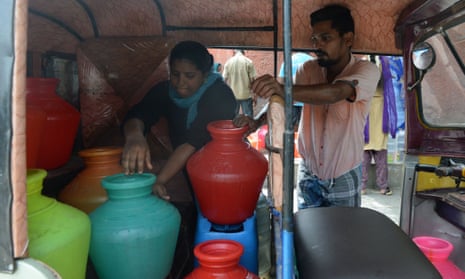Authorities in Chennai have been criticised for failing to deal with a crippling water shortage that has brought the Indian city to crisis point, leaving taps dry in homes and forcing schools, offices and restaurants to close as temperatures soar.
The four reservoirs supplying the bulk of the city’s drinking water have completely dried up, leading the Chennai Metro Water to cut the water it provides by about 40%.
The crisis in India’s sixth largest city comes as the country struggles to deal with a heatwave that has caused hundreds of deaths, with 184 people killed just in the eastern state of Bihar. Temperatures reached 48C near the airport in Delhi last week and above 50C in Rajasthan.
The water shortage in Chennai started several weeks ago and Madras’s high court has criticised the Tamil Nadu state government for inaction. The court accused the government on Tuesday of waiting passively for the arrival of the monsoon instead of proactively handling the water crisis which, it said, did not happen in a day.
Entire families are managing their drinking and cooking needs with two or three pots of water in searing temperatures of more than 40C. Residents are forced to wait for municipal or private water tankers to bring drinking water, leaving little or nothing for laundry or bathing. The arrival of a tanker prompts a rush of women carrying colourful plastic pots to fill up. The Chennai metro has turned off the air conditioning in stations.
Doctors and staff at the small 24-bed, orthopaedic Tosh hospital, said they are “just about managing” with a municipal tanker coming twice a week. “We have really rationed water use and have enough, for the moment, for the ward toilets and the toilets in OPD [the out-patient department] but it’s becoming alarming,” said Dr Prabhu Manickam, an orthopaedic surgeon at the hospital.
Many student hostels have closed. Some software companies have sent employees home because of the water shortage but, as one employee said, being at home is no solution as the taps there are also dry.
“We have stuck big ‘save water’ signs on every tap and have meetings with the staff every day to hammer home the need to conserve every drop. Luckily we have our own borewell for our water supply but even that seems to be drying up,” said Naseem Sheikh, the manager of the Marina chain of restaurants in Chennai.
The reasons for the water shortage are complex but experts cite as one reason unplanned urban development that has destroyed the wetlands around the city. There is little or no recycling of water or rainwater harvesting.
Nor has there been any political will to address the problem comprehensively. Politicians rely on the monsoon and when it is late, as it is this year, and when the rainfall is inadequate, as it has been for several years, there are no policies in place to compensate for the shortfall. The inadequate rainfall in past monsoons has led to groundwater levels plummeting.
While the middle class can just about manage to pay the inflated prices currently being charged by private water-tanker companies, that option is not open to the poor.
The Indian media have reported slum-dwellers fleeing their homes in desperation for railway stations and shopping centres in the hope of finding functioning toilets and drinking water.
Tamil Nadu’s chief minister, Edappadi K Palaniswami, said on Tuesday residents would have to wait until the monsoon arrived and claimed the water crisis was being exaggerated by the media.
“In case of a water issue somewhere, it should not be blown up to give a false impression that the entire state is reeling from water scarcity,” he was quoted as saying in local newspapers.
In a report released on 14 June2018, the top government thinktank for the economy, NITI Aayog, said India was facing the worst water crisis in its history. It predicted that 21 cities would run out of groundwater by 2020 and recommended “urgent and improved” management of water resources.
Even if water were more plentiful, it is estimated only one in five rural homes has a piped water connection. Soon after being reelected to office on 23 May, the prime minister, Narendra Modi, said he wanted to change this situation. He promised Indians that his government would aim to provide piped water to all homes by 2023. The irony of the promise, given the water crisis, has not been lost on Indians.
